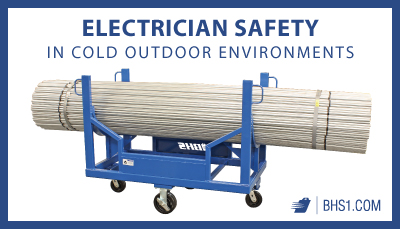We use cookies to make your experience better. To comply with the new e-Privacy directive, we need to ask for your consent to set the cookies. Learn more.
Electrician Safety in Cold Outdoor Environments
Electrical contractors can't simply pack up and wait out the winter weather; eventually, electricians just have to work in the cold. Extreme temperatures create special hazards, especially for electricians, and staying safe in the depths of winter requires special efforts on the part of employers and employees alike.
The Occupational Safety and Health Association breaks down their safety rules for working in cold and snow into three categories: plan, equip, and train. Here's what that means for electricians working outside on a freezing Midwestern or Northern day:
-
Employers should invest in engineering controls to help limit the risk.
As you know if you've read any of our previous entries on ergonomics, "engineering controls" are the most powerful way to keep employees safe. Essentially, the term describes anything that removes the risk of musculoskeletal injuries, whether that's a new way of doing things or a new piece of equipment.
Radiant heaters will go a long way toward reducing the risk of working in the cold, particularly if staff are inside an unfinished structure. Electricians on an installation job can also complete jobs faster by using specialized material handling equipment to keep cables and conduit right up front, where it's needed.
Conduit Carrier Carts from BHS offer a simple and dependable way to transport up to 5,000 pounds of conduit. A slim profile allows these specialized material handling carts to navigate narrow aisles, delivering a full job's worth of conduit right to the site of installation.
-
Employees should dress to protect themselves from the cold.
While employers aren't required to provide warm clothing under OSHA's standard about personal protective equipment (PPE), it might be worth it for employers to supply winter coats and gloves. Otherwise, employees will have to wear their own warm clothing — which should include at least three layers, starting with an inner layer that wicks away moisture (such as wool or certain synthetic cloths).
-
Every employer should provide ongoing training in the hazards of winter weather, as well as the latest techniques to keep work safe in the cold.
Staff must thoroughly understand the risks of working in the cold in order to avoid them. A robust training program will teach workers how the body can react to the cold, how to recognize the signs of frostbite, hypothermia, and trenchfoot, and how wind chill affects functional temperature.
Employers should train their staff to watch out for signs of encroaching damage from the cold, both in themselves and in co-workers. Remember that workers who have certain illnesses, such as cardiovascular disease, diabetes, or high blood pressure, may be at a greater risk for weather-related injury.
-
Understand the hazards of snow, ice, and freezing rain.
Snow and ice present particular hazards for electrical contractors. First, an icy surface increases the risks of slips and falls. OSHA instructs outdoor workers at construction sites to wear insulated, water-resistant boots with rubber soles. Staff should also move slowly and carefully in the snow.
Second, snow and ice tend to melt, creating puddles of water all around the worksite. Electricians are well-versed in the dangers of water and electricity, but they must take special care during winter storms, both indoors and out.
High-quality electrical components can improve safety, as well. Occupational Health & Safety magazine recommends the use of conductors that are rated as safe for damp conditions, especially in regions with harsh winters.

Maintaining Electrician Safety with Custom Engineering Controls
By following these tips, and by providing material handling equipment designed for rough, outdoor environments, every electrical contractor can keep taking jobs through the winter. As long as you're prepared, it doesn't matter how cold it gets; you can still get the job done.
References:
"Cold Stress Guide." OSHA. Occupational Safety and Health Administration, United States Department of Labor, n.d. Web. 13 Aug. 2017.
"Tips To Protect Workers In Cold Environments." OSHA. Occupational Safety and Health Administration, United States Department of Labor, n.d. Web. 13 Aug. 2017.
"Winter Hazards in Manufacturing." OHSOnline. 1105 Media, 1 Oct. 2014. Web. 16 Aug. 2017.
"Winter Weather." OSHA. Occupational Safety and Health Administration, United States Department of Labor, n.d. Web. 13 Aug. 2017.
